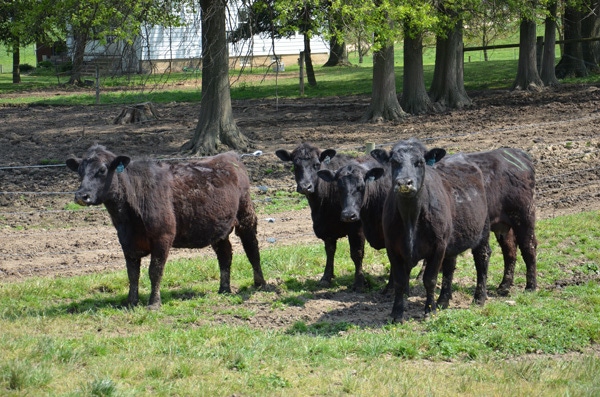Heifer Retention Remains Cautious
Judging by chatter and heifer prices at auction, more producers are at least contemplating herd expansion. But, looking at the mix of heifers on feed, Nevil Speer at Western Kentucky University says, "Producers don’t appear to be settling into the commitment associated with heifer development.” He adds that could change as marketing season continues.
November 9, 2013

Mom Nature is cooperating, for the most part. Feed prices, forage availability and calf prices make it possible. There are indications it could be in its nascent stage, but no one knows when herd expansion will begin in earnest, much less how long it will last and how many cows will ultimately be added.
“Cow-calf producers appear to have a growing incentive for herd expansion with strong profit prospects and improved forage conditions,” says Lee Schulz, Iowa State University Extension livestock economist, in the latest Iowa Farm Outlook. “Though 2013 is likely another year of herd liquidation, improving forward returns may provide the period of herd stabilization (with little or no growth) that often occurs in the first year of herd expansion. The ultimate question becomes, given the uncertainty experienced the last several years, what level of return will be required to encourage producers to begin rebuilding the cowherd? In other words, what level of annual return would motivate producers to assume risk in retaining more heifers and/or investing in additional cows?”
Schulz notes that the Livestock Marketing Information Center estimates cow-calf returns over cash costs at more than $300/head next year.
On the other hand, Nevil Speer at Western Kentucky University explains in this week’s BEEF Cow-Calf Weekly, “Early indications are that the heifer portion of the feeder cattle mix has remained relatively steady. In other words, producers don’t appear to be showing much proclivity toward retaining heifers either off the cow or grass during the early part of the marketing season.”
Speer explains the mix of heifers on feed—36% in the most recent Cattle on Feed report—has been steady for the past six quarters.
“There continues to be lots of discussion around higher prices and the apparent incentive to rebuild the cowherd. However, early indicators suggest that doesn’t appear to be the case,” Speer says. “Producers don’t appear to be settling into the commitment associated with heifer development.” He adds that could change as marketing season continues.
In the meantime, Glynn Tonsor, Kansas State University (KSU) livestock economist, encourages folks contemplating expansion to make full use of the tools available to analyze the possibilities.
For example, in this week’s In the Cattle Markets, Tonsor mentions a spreadsheet, KSU Beef Replacement, developed by KSU colleague, Kevin Dhuyvetter.
“Using what currently appears to be fairly conservative calf prices over upcoming years (averaging $169/cwt. for 562 lbs. calves) and a base for cow costs of $700/year, the spreadsheet suggests purchasing a replacement for $1,420 in anticipation of her producing calves for the next five years would provide an expected return on investment of 7.5%,” Tonsor says. “Similarly, if a replacement was purchased for $1,522, where 10 years of production were expected, the estimated return on investment would be 7.5%. Any purchases at levels lower (higher) than these price level levels would provide better (worse) expected returns. Similarly, producers with lower (higher) annual cow costs can pay significantly higher (lower) prices for replacements to achieve the same expected rate of return. Stated differently, producers with lower annual cow costs or expectations of a given replacement producing for longer periods will see higher economic value in replacements available for purchase.”
Tonsor explains the spreadsheet can be adjusted easily for a given producer’s situation regarding costs and production along with expectations of cattle prices over upcoming years and targeted rates of return.
Subscribe now to Cow-Calf Weekly to get the latest industry research and information in your inbox every Friday!
On the other end of the spectrum, Glenn Selk, Oklahoma State University emeritus Extension beef cattle specialist, reminded producers earlier this week that adding weight to cull cows can represent one of those rare opportunities in the cattle business to increase both weight and the selling price per pound.
“Producers that sell cull cows should pay close attention to the market news reports about the price differentials of the cows in these classes (Breakers, Boners, Leans, Lights),” Selk explained. “Cull cows that can be fed enough to gain body condition to improve from the Lean class to Boner class can gain weight and gain in value per pound at the same time. Seldom, if ever, does this situation exist elsewhere in the beef business.”
One thing’s for sure. Too few cattle for too long has already taken some capacity from cattle feeding and packing, and likely only a hint of what will exit the business over the next 12-18 months.
You might also like:
Horse Slaughter, Horse Welfare A Victim of Legal Maneuvering
Use These Late-Year Tips To Cut The Taxman's Bite
BEEF Tech: 9 New Products For Fall 2013
Carcass Weights Decline and Grade Increases
How To Diagnose, Treat Hoof Cracks In Cattle
Average Value Of U.S. Pastureland Is $1200 Per Acre
About the Author(s)
You May Also Like




.png?width=300&auto=webp&quality=80&disable=upscale)
